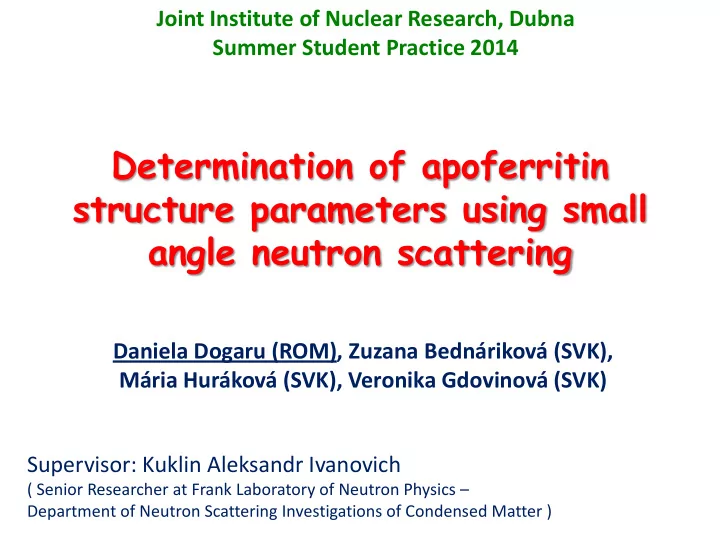

Joint Institute of Nuclear Research, Dubna Summer Student Practice 2014 Determination of apoferritin structure parameters using small angle neutron scattering Daniela Dogaru (ROM) , Zuzana Bednáriková (SVK), Mária Huráková (SVK), Veronika Gdovinová (SVK) Supervisor: Kuklin Aleksandr Ivanovich ( Senior Researcher at Frank Laboratory of Neutron Physics – Department of Neutron Scattering Investigations of Condensed Matter )
OUTLINE Small Angle Neutron Scattering - introduction to the SANS technique ATSAS program package - data treatment - structure modeling determine structural parameters of Apoferritin - radius of gyration, diameter - low resolution structure model
Small Angle Neutron Scattering (SANS) an experimental technique that uses coherent and elastic neutron scattering at small scattering angles to investigate the structure of various substances at a scale of about 1 - 100 nm spectrum : Scattering Intensity I as a function of a wavevector Q 1E8 ( ) ( ) ( ) I Q P Q S Q 1E7 log I I(Q) = scattering intensity 1000000 Ø = density of particles in volume Q = wavevector Ɵ = scattering angle P(Q) =<|F(Q)| 2 >, F(Q)- form factor 100000 λ = Wavelength of incident beam S(Q) = structure factor 0,01 0,1 q
Information obtained by SANS: - sizes, spatial correlations and shapes of particles in crystalline, solution or amorphous states - phase transitions and degree of polydispersity - molecular weight Applications: biology (viruses, proteins, lipids,....) chemistry (polymers, colloids, gel,...) material technology (ceramics, powder,...)
EQUIPMENT YUMO spectrometer 1 – two reflectors; 2 – zone of reactor with moderator; 3 – chopper; 4 – first collimator; 5 – vacuum tube; 6 – second collimator; 7 – thermostate; 8 – samples table; 9 – goniometer; 10-11 – Vn-standard; 12 – ring-wire detector; 13 – position-sensitve edetector "Volga"; 14 – direct beam detector
ATSAS program package created by Svergun et al. at EMBL in HAMBURG programs suite for small-angle scattering data analysis from biological macromolecules 1. PRIMUS (manipulations with experimental 1D SAS data) 2. GNOM (indirect transform program that evaluates the particle distance distribution function p(r)) 3. DAMMIN ( ab initio shape determination using a dummy atom model) 4. MASSHA (interactive modelling of atomic structures and shape analysis)
DETERMINING of Rg 1E8 1E7 log I 1000000 100000 0,01 0,1 -1 q, A Fit for SANS experimental data for apoferritin. Guinier approximation for a globular particle in PRIMUS: Spherical shape with Rg = 55.0 0.323 1/A
APOFERRITIN globular protein complex present in every cell type the primary intracellular iron-storage protein keeping iron in a soluble and non-toxic form known structure parameters (X-ray crystalography, NMR) - size : 450 kDa with 24 subunits - diameter : 120 Å - spherical shell → inner radius: 4 0Å → outer radius: 6 0Å Image obtained from Protein Data Bank
DISTANCE DISTRIBUTION FUNCTION The analysis of this function helps to find structural details about the molecule. spherical molecule with shell structure Distance distribution function obtained using GNOM
DETERMINING of STRUCTURE FACTOR S(q) I ( Q ) P ( Q ) S ( Q ) 10 experimental data theoretical fit 1 3 3 2 3 3 2 I ( q ) ( R R ) [ R ( qR ) R ( qR )] 1 2 1 1 2 2 0,1 -1 Intensity, cm 0,01 t sin t t cos t qR ( ) 3 , t 3 1E-3 t 1E-4 1E-5 1E-6 1E-7 Structure factor 0,01 0,1 -1 q, A 1 0,01 -1 q, A
DAMMIN 3D MODELING TOOL method to restore ab initio low resolution shape of randomly oriented particles in solution a search volume which encloses the particle is filled with dummy atoms apoferritin → model of spherical shell Projection of obtained apoferritin structure with programs DAMMIN.
CONCLUSIONS from the experimental data were obtained the experimental curves (PRIMUS) using ATSAS package (PRIMUS, GNOM) we determined: - the radius of gyration – Rg = 55 0.323 - distance between molecules ~ 85Å - diameter – d ~ 110Å - structure factor - model for apoferritin molecule using DAMMIN - apoferritin has spherical shell structure which is in agreement with structures obtained with different methods (X-ray, NMR)
REFERENCES Feigin L.A. & Svergun D.I. (1987). Structure Analysis by Small-Angle X- Ray and Neutron Scattering. In NY: Plenum Press . J. Texeira (1992). Introduction to Small Angle Neutron Scattering Applied to Colloidal Science. In Kluwer Academic Publishers, Netherlands. D. I. Svergun (1999). Restoring low resolution structure of biological macromolecules from solution scattering using simulated annealing. In Biophys J. 2879-2886. P.V. Konarev, V.V. Volkov, A.V. Sokolova, M.H.J. Koch and D. I. Svergun (2003). PRIMUS - a Windows-PC based system for small-angle scattering data analysis. In J Appl Cryst . 36, 1277-1282. A .I. Kuklin, T. N. Murugova, O. I. Ivankov, A. V. Rogachev, D. V. Soloviov, Yu. S. Kovalev, A. V. Ishchenko, A. Zhigunov, T. S. Kurkin, V. I. Gordeliy (2012). Comparative study on low resolution structures of apoferritin via SANS and SAXS. In J Phys: Conference Series 351.
ACKNOWLEDGEMENT The team would like to thank the members of the Frank Laboratory of Nuclear Physics and the YuMO SANS team for all their support and especially to our supervisor Dr. A.I.KUKLIN for his guidance and patience. We would like to extend our regards to the organizers of the Summer Student Practice 2014 and all members of the JINR involved with this project .
THANK YOU FOR YOUR ATTENTION !
Recommend
More recommend